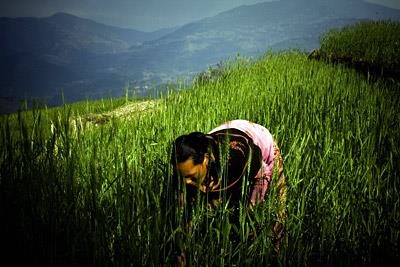
In 2008, as the cost of foodstuffs reached record levels, FAO launched a series of input supply projects to help farmers grow more food and earn more money, via its Initiative on Soaring Food Prices. In Nepal - a country reeling from a decade-long conflict and struggling with drought-induced food shortages - this effort helped generate more resources. One such project, funded by the UN's Central Emergency Response Fund, has helped keep thousands of vulnerable Nepalese farmers from falling deeper into poverty and hunger.
13 July 2010, Parbat and Myagdi, Nepal - Even in a four-wheel jeep it takes nearly an hour and a half to drive the bumpy 15-kilometre stretch up from the foothills to the small hilltop village of Durlung, in Nepal's western region.
This is nothing compared to the three or four hours it takes villagers to walk down the steep hill to the nearest large market - not to mention the slog back up.
"We've tried using the bus, but it charges too much," said San Kumai Gurung, 43, who, like her neighbours, carries heavy produce and supplies in a woven basket on her back to and from town.
Most rural Nepalese, like the families of Durlung, survive by growing crops and raising livestock. Their plots of land are small - usually much less than one hectare - and access to good seeds and irrigation is patchy, making it difficult for them to produce enough food to feed their families throughout the year.
Add to the mix increasingly unpredictable weather, high food and fuel prices and limited options for earning money in other ways, and it becomes clear just how precarious their situation is.
Vegetables boost diets
Last year, however, on the heels of a severe 2008/2009 winter drought that withered crops and widened hunger gaps, thousands of farmers in this region managed to boost their food production thanks in part to high-yielding seeds and fertilizers provided by FAO. Though it was a short-term emergency project, many farmers were able to keep seeds to use for this year's planting season.
Working closely with the government and local NGOs, FAO reached out to 30 000 vulnerable farming families in six districts in the country's western region, giving priority to farmers owning less than half a hectare of land, struggling with crop loss or marginalized because of caste or ethnicity, as well as female-headed households.
While many families received either rice or maize seeds depending on where they lived, all received vegetable seeds - nine different varieties ranging from bitter gourd and okra to French bean and radish.
"Before, farmers basically grew vegetables like potatoes and cauliflower," said Sangita GC, chairperson of the Rural Environment and Empowerment Center, one of FAO's local partners in Myagdi District. "Poorer families couldn't really afford to buy fresh vegetables, only preserved ones. Now they are eating more fresh produce and are even able to sell some for income."
Increased earnings
Resham Kishan, 47, made more than $800 from selling his surplus vegetables - nearly double what he had made in previous years and well above Nepal's average per capita household income of almost $500.
The extra cash has allowed him to put aside more money for emergencies he said, adding that had it been a viable option years earlier, he could have kept his two daughters, now grown, in school alongside their brother.
Saraswati Giri, 39, and her husband Dal Giri, 40, would eventually like to use more of their land to grow off-season vegetables throughout the year rather than rice. Vegetables fetch a better price at market, enabling them to buy the staples they need and to keep their children in school.
"If we can provide for their education and arrange for their marriages, then we are doing fine," said Mr Giri, who, like many Nepalese, worked abroad for several years to support his family until an injury, which nearly left him without the use of one hand, brought him back to Nepal.
Challenges to growth and development
While the Giris live relatively close to the area's main markets - about 45 minutes by foot - others are not as well connected.
"We could have sold double that if we had better roads," said Durlung farmer Khadka Bahadur Gurung, 44, referring to the extra $150 he pulled in last year from selling vegetables.
The remoteness and inaccessibility of so many of Nepal's rural villages are among the country's thorniest challenges to growth and development. Political instability, poor rural infrastructure, lack of irrigation and arable land and changing weather patterns are others.
Getting agriculture back on track
With more than three million people now in need of food aid - in a landlocked country that was once self-sufficient in food production - agricultural investments are all the more pressing.
Small-scale farmers throughout the country not only need improved access to markets, information and services but training in better cropping practices, improved soil and water management, seed multiplication and storage and livestock rearing, especially for those without land of their own.
Such investments could go a long way toward helping Nepalese farmers withstand future shocks and begin to turn the picture around from a reliance on food aid to long-term food security.